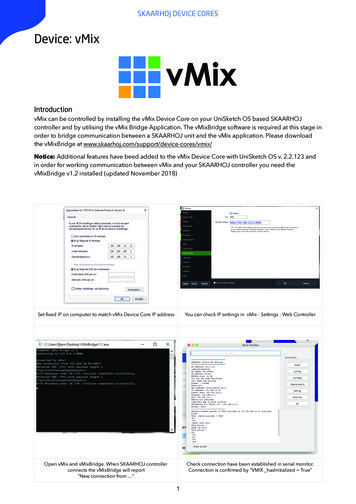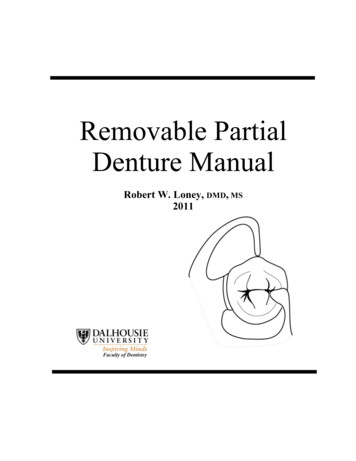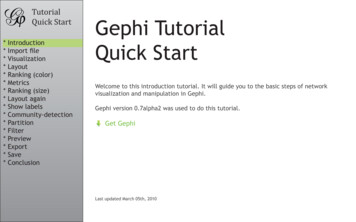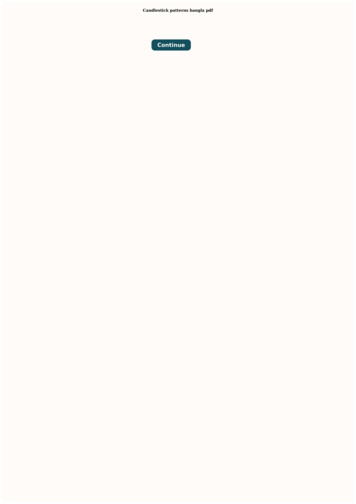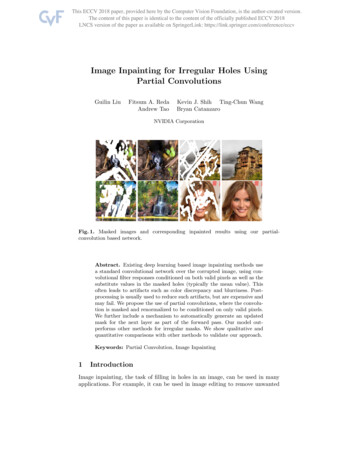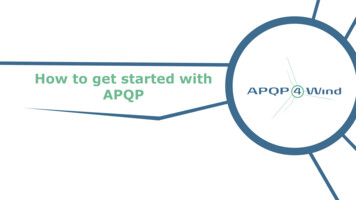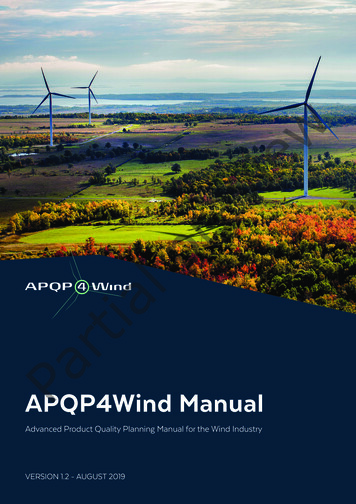
Transcription
viewrelpiartPaAPQP4Wind ManualAdvanced Product Quality Planning Manual for the Wind IndustryVERSION 1.2 - AUGUST 2019
APQP4WindLysbrohøjen 248600 SilkeborgDenmarkviewMail: contact@apqp4wind.orgWebsite: www.apqp4wind.orgLinkedIn: APQP4WindText and data:Manual and Toolbox developed by the APQP4Wind Working Group and Board of DirectorsPhoto credit, front page:GE Renewable EnergyMcLean’s Mountain Wind Farm, CanadaPhotographer: John HryniukCopyright:APQP4Wind, all rights reservedreLayout and print:Digitalprint - EgetryklpVersion:Advanced Product Quality Planning Manual for the Wind IndustryVersion 1.2 - August 2019Ivan MikkelseniaContributors:Bureau Veritas CertificationDNV GL Bent WeibelKaren VejbyrtGE Renewable EnergyJessica Groff BarrKevin CreaganPaKK Wind SolutionsClaus Lindberg OlesenKarolina Zielinska Kim Schmidt PetersenLM Wind Power Abhay WaghmareFlemming Skov IversenSiemens Gamesa Renewable EnergyDev Anand PrakashHenning HeckerHenrik HjortkjaerLee ButcherVestas Wind SystemsArun John SelvaHenning Bach JokumsenVinayan EP
Introduction to APQP4WindAt the beginning of 2014, Wind Denmark (formerly known as the Danish Wind IndustryAssociation) started a network group consisting of Suppliers with an interest in qualityassurance. To strengthen the network, wind turbine manufacturers and utility companieswere invited to participate on equal footing with the Suppliers.viewIn February 2014, the first meeting in Wind Denmark’s Quality Assurance (QA) networktook place. This marked the very beginning of quality assurance cooperation between windturbine manufacturers, utility companies and Suppliers within the Danish windindustry, and subsequently the idea of APQP4Wind was born.With facilitation from Wind Denmark and support from the Danish Industry Foundation,Siemens Gamesa Renewable Energy and Vestas Wind Systems shared leadership of theAPQP4Wind project running from 2015 to 2018 in cooperation with KK Wind Solutions andLM Wind Power.In August 2018, APQP4Wind was established as an independent organization with globalreach and a board of directors representing GE Renewable Energy, KK Wind Solutions,LM Wind Power, Siemens Gamesa Renewable Energy, Vestas Wind Systems, and WindDenmark.The purpose of APQP4WindreAPQP4Wind is a common quality assurance methodology for the global wind industry.The background for the APQP4Wind Manual is the continuous quality improvement that isneeded to reduce risk, lower the costs of poor quality and keep pace with the ongoing trendtowards decreases in the Levelized Cost of Energy within the wind industry.lpAdvance Product Quality Planning (APQP) is a well-known concept within the automotiveindustry and has been the backbone for maturing quality performance at Customers andSuppliers for decades. In the context of APQP4Wind, the concept of APQP in this Manual isadapted to the business areas and special conditions differentiating wind fromautomotive.rtiaThe APQP4Wind Manual aims to make the process of product quality assurance demandsas well as Production Part Approval Process (PPAP) as clear as possible. The Manual is madeto fit the entire wind industry and set a common standard and best practice for how to planand execute quality assurance in the entire supply chain, from manufacturers to Suppliers ofcomponents.The standards made available in this Manual are made to substitute company-specificprocedures and set aligned methods and procedures for all Suppliers and Sub Suppliers toreduce time to market and increase efficiency within the global wind industry.PaThe APQP4Wind Manual has been subjected to multiple reviews involving subject matterexperts from the APQP4Wind Working Group, Board of Directors, members of WindDenmark’s QA network and a certifying body.All future activities, documents and references can be found at:www.apqp4wind.orgThe APQP4Wind Manual will refer several times to the Toolbox consisting of a Workbookand Analysis 1
Table of ContentsIntroduction5Supply Chain Pyramid5Product Quality Planning Cycle6Responsibility Matrix7APQP4Wind Framework8APQP4Wind Process Flow8Phase Input & Output91.1.Voice of Customer1.2. Design Goals1.3.Product & Process Benchmark Data1.5.Historical Data & Quality Information111.6.Sub Supplier Screening111.7.APQP Kick Off1.8.Product Quality Planning Teamre112.1.Engineering Design Review (EDR)1212121313142.3. Team Feasibility Commitment (TFC)142.4. DFMEA (Design Failure Mode & Effect Analysis)152.5. Special Characteristics152.6. Design for Manufacturability, Assembly, Transport & Service162.7. Design Verification Plan (DVP)162.8. New Equipment, Tooling, Gauge/Test & Facilities Requirement162.9. Preliminary BOM & BOM Management172.10. Sub Supplier Assessments172.11. Engineering Change Management (ECM)17rtialp2.2. Drawing & Specification ReviewPhase 3. Product Requirement FulfillmentPa111.4. Product & Process AssumptionsPhase 2. Product Design & DevelopmentAPQP4Wind10111.9. Product Quality Plan (PQP)210viewPhase 1. Plan, Define & Scope Quality Program3.1.Design Verification Report (DVR)18183.2. Tool Design & Approval183.3. Sub Supplier Product Quality Plan193.4. Customer Engineering Approval193.5. Prototype Control Plan193.6. Prototype Builds19
Phase 4. Process Design & Development4.1.20Preliminary Process Flow Chart & Floor Plan204.2. PFMEA (Process Failure Mode & Effect Analysis)214.3. MSA Plan (Measurement System Analysis)214.4. Preliminary Process Capability Study Plan224.5. Packaging & Transport Specifications22Phase 5. Process Requirement FulfillmentProcess Flow Chart & Floor Plan5.2.Production Tool Builds5.3.0-Series Control Plan5.4.Work Instructions5.5.Preliminary Process Capability Study5.6.Sub Supplier PPAP Completion232424Phase 6. Product & Process Validation0-Series Production6.2.Performance Test Report & Certification6.3.Material Test Report & Certification242425252526266.5.Appearance Approval Report266.6.MSA Report (Measurement System Analysis)266.7.Product Validation Testing266.8.Form, Fit & Function (FFF)276.9.lpre6.1.6.4. Dimensional Report23view5.1.23Serial Production Control Plan276.10. Packaging & Transport EvaluationiaPhase 7. Product & Process Approval2728PPAP Documentation (Production Part Approval Process)287.2.Master Samples287.3.PPAP Submission & PSW (Part Submission Warrant)29Part7.1.APQP4Wind3
APQP4Wind – Glossary & Abbreviation29APQP4Wind – Appendix List1Special Characteristics32Appendix2Failure Mode & Effect Analysis (FMEA)34Appendix3Process Capability Studies42Appendix4Measurement System Analysis (MSA)44Appendix5Production Part Approval Process (PPAP)48PartialpreviewAppendix4APQP4Wind
IntroductionThe purpose of this document is to communicate to Suppliers and Sub Suppliersa common Advanced Product Quality Planning (APQP) Manual developed by theAPQP4Wind Organization. The Manual provides the information and requirements todevelop a product quality plan that should enable development and production of productor service that will fulfill wind turbine manufacturers’ requirements.The main objective of the approach outlined in this Manual is to: Reduce the risk of defects and the costs of quality when introducing new designsviewand components, thereby bringing down the costs of energy. Reduce complexity. Improve alignment of Product Quality Planning (PQP) in the wind industry value chain.Provide an effective medium to easily communicate product qualityrequirements to Suppliers and Sub Suppliers.Avoid problem/failure repetition.The key benefits for the wind industry of using the approach described in this Manual are: and increase efficiency.Support profitable growth.re Preventive approach to quality. Shift from quality control to quality assurance. Enable maturing of the Supplier base globally. Support standardization and simplification of processes to reduce time to marketrtialpThe purpose of this Manual is to provide guidance to Suppliers on the quality requirementsand enable organizations to develop appropriate communication forms. This Manualsupports the quality requirements in the wind power industry by providing recommendedformats and templates such as the Product Quality Plan (PQP). Supplier shall comply withCustomer specific quality requirements specified in addition to this Manual.Environmental, Health and Safety (EHS) requirements are not in scope of this Manual,however, the Supplier shall comply with the legal or Customer specific requirements withrespect to EHS shall be complied.The term “product” used throughout this Manual should be interpreted as the system, subsystem, component or service provided.PaSupply Chain PyramidWind PowerCustomerOriginalEquipment ManufacturerTier 1 SupplierDefinitions: “Wind Power Customer”: Client and/or End-User of OriginalEquipment Manufacturer’s product. “Original Equipment Manufacturer”: Wind turbinemanufacturer also called “OEM”. “Tier 1 Supplier”: Direct Suppliers to the Original EquipmentManufacturer. “Tier 2 Supplier”: Supplier to Tier 1 Suppliers. Suppliers alsocalled sub-tier Supplier to “OEM”.Tier 2 SupplierThe above illustration depicts the supply chain structure applicable to this Manual.APQP4Wind5
The scope of this Manual with respect to the Supply Chain Pyramid is further clarified bythe Customer-Supplier relationship model below. The Customer-Supplier levels may extendbeyond Level 3. The requirements in this Manual shall be applicable to all levels exceptLevel 1 of the model. Hereafter, the words 'Customer' and 'Supplier' are used based on thebelow model.CustomerOriginalEquipmentManufacturerTier 1(Supplier)OriginalEquipmentManufacturerLevel 1viewWind PowerCustomerSupplierTier 1(Supplier)Level 2Tier 2(Sub Supplier)Level 3Product Quality Planning CyclereThe Product Quality Planning Cycle is shown below as a graphical illustration of theAPQP4Wind Quality Program. The various phases are sequenced to represent plannedtiming and follow a typical Plan-Do-Check-Act (PDCA) cycle.lpThe purpose of the Product Quality Planning Cycle is: To set a clear path for planning, implementing and verifying the productconformance to requirements through quality assurance activities. To enable Suppliers and Sub Suppliers to deliver products with the required qualityand quantity, right the first time and on time.iaProduct& ProcessApprovalPlan, Define& Scope QualityProgramActrtPlanCheckPaProduct & uctDesign &DevelopmentThe Product Quality Planning Cycleemphasizes a cross functional approachbetween the Customer and Supplier,thereby improving communication andcollaboration in the entire product sDesign &DevelopmentReference:WorkbookSheet: ProductQuality PlanAs an outcome of product quality planning, the Supplier shall have a Product Quality Planwhich contains a list of quality deliverables that are outcomes of various quality assuranceactivities that the Supplier executes.The level of activities in the Product Quality Plan may vary, based on the product beingdeveloped.6APQP4Wind
Responsibility Matrix3.0ProductRequirementFulfillmentVoice of CustomerxDesign Goalsx1.3Product & Process Benchmark Dataxx1.4Product & Process Assumptionsxx1.5Historical Data & Quality Informationxx1.6Sub Supplier Screeningxx1.7APQP Kick Offxx1.8Product Quality Planning Teamxx1.9Product Quality Plan (PQP)2.1Engineering Design Review (EDR)Drawing & Specification Review2.3Team Feasibility Commitment (TFC)2.4DFMEA (Design Failure Mode & Effect Analysis)2.5Special Characteristics2.6Design for Manufacturability, Assembly, Transport & Servicexxxxxxxxxx2.7Design Verification Plan (DVP)New Equipment, Tooling, Gauge/Test & Facilities Requirementxx2.9Preliminary BOM & BOM Managementxx2.10Sub Supplier Assessmentsxx2.11Engineering Change Management (ECM)xx3.1Design Verification Report (DVR)3.2Tool Design & Approval3.3Sub Supplier Product Quality Planxxxxx3.4Customer Engineering Approvalxx3.5Prototype Control Planxx3.6Prototype Buildsxx4.24.34.4xxxxMSA Plan (Measurement Systems Analysis)xxPreliminary Process Capability Study PlanxxPackaging & Transport SpecificationsxxxProcess Flow Chart & Floor PlanxProduction Tool Buildsxx0-Series Control Planxxia5.2Preliminary Process Flow Chart & Floor PlanPFMEA (Process Failure Mode & Effect Analysis)5.35.4Work Instructionsxx5.5Preliminary Process Capability Studyxx5.6Sub Supplier PPAP Completionxx6.10-Series Productionxx6.2Performance Test Report & Certificationxx6.3Material Test Report & Certificationxx6.4Dimensional Reportxx6.5Appearance Approval Reportxx6.6MSA Report (Measurement System Analysis)xxxrtPa7.0Product & ProcessApprovalx2.85.16.0Product & llmentx1.14.14.0Process Design &DevelopmentManufactureto Spec Supplierview2.0Product Design &DevelopmentDesignResponsibleSupplier1.2re1.0Plan, Define &Scope ndPhasesSupply Nature6.7Product Validation Testing6.8Form, Fit & Function (FFF)xx6.9Serial Production Control Planxx6.10Packaging & Transport Evaluationxx7.1PPAP Documentation (Production Part Approval Process)xx7.2Master Samplesxx7.3PPAP Submission & PSW (Part Submission Warrant)xxDesign Responsible Supplier:Suppliers who own the design of the product, for example - gearbox Supplier.Manufacture to Specification/Material Processing Supplier:Suppliers who do not own the design of the product, but manufacture based on drawing, specifications and requirementsby the Customer. This category also includes Suppliers who perform specific processes e.g. heat treatment, surfacetreatment etc. on Customers’ material based on the requirements provided by Customer.APQP4Wind7
APQP4Wind APProcess0 - SeriesBuildProduct RequirementFulfillmentProcess Design & DevelopmentFinal PPAPApprovalSerialProductionviewProduct Design &DevelopmentPrototype eBuildPlan, Define & ScopeQuality ProgramApprovalProcess Requirement FulfillmentProduct & Process Validation0 - Series StageProduct & ProcessApprovalreSeries StagelpThe above graphic shows the 3 stages of the 7 phases of APQP4Wind.Each phase will be described in more details in subsequent sections of this Manual.APQP4Wind Process Flowia Initiate QualityProgram & FormTeamSubmit PPAP No Develop ProductQuality Plan8APQP4WindPlan & ScopePPAPDiscuss & AgreeCorrection Plan Product & ProcessApprovalPSWDocumentsYes PaOther SpecificRequirementsReceive & ReviewPPAP TechnicalSpecificationsDrawingsExecute ProductQuality Plan rt Process DesignRequirementsReceive & ReviewRequirementsCustomerReview & ApprovalPPAPDocuments Product DesignRequirementsSupplierExecution CustomerRequirementsSign PSW &CommunicateResults
Phase Input & OutputInput1.21.61.71.81.9InputDesign GoalsSub Supplier ScreeningAPQP Kick OffProduct Quality Planning TeamProduct Quality Plan (PQP)4.0Process Design 3.23.33.43.53.6InputEngineering Design Review (EDR)Drawing & Specification ReviewTeam Feasibility Commitment (TFC)DFMEA (Design Failure Mode & Effect Analysis)Special CharacteristicsDesign for Manufacturability, Assembly, Transport & ServiceDesign Verification Plan (DVP)New Equipment, Tooling, Gauge/Test & Facilities RequirementPreliminary BOM & BOM ManagementSub Supplier AssessmentsEngineering Change Management (ECM)InputEngineering Design Review (EDR)Drawing & Specification ReviewTeam Feasibility Commitment (TFC)DFMEA (Design Failure Mode & Effect Analysis)Special CharacteristicsDesign for Manufacturability, Assembly, Transport & ServiceDesign Verification Plan (DVP)New Equipment, Tooling, Gauge/Test & Facilities RequirementPreliminary BOM & BOM ManagementSub Supplier AssessmentsEngineering Change Management (ECM)Design Verification Report (DVR)Tool Design & ApprovalSub Supplier Product Quality PlanCustomer Engineering ApprovalPrototype Control PlanPrototype BuildsInputPreliminary Process Flow Chart & Floor PlanPFMEA (Process Failure Mode & Effect Analysis)MSA Plan (Measurement Systems Analysis)Preliminary Process Capability Study PlanPackaging & Transport InputProcess Flow Chart & Floor PlanProduction Tool Builds0-Series Control PlanWork InstructionsPreliminary Process Capability StudySub Supplier PPAP ries ProductionPerformance Test Report & CertificationMaterial Test Report & CertificationDimensional ReportAppearance Approval ReportMSA Report (Measurement System Analysis)Product Validation TestingForm, Fit & Function (FFF)Serial Production Control PlanPackaging & Transport EvaluationPa6.0Product & ProcessValidation7.0Product & ProcessApprovalDesign GoalsSub Supplier ScreeningAPQP Kick OffProduct Quality Planning TeamProduct Quality Plan (PQP)OutputEngineering Design Review (EDR)Drawing & Specification ReviewTeam Feasibility Commitment (TFC)DFMEA (Design Failure Mode & Effect Analysis)Special CharacteristicsDesign for Manufacturability, Assembly, Transport & ServiceDesign Verification Plan (DVP)New Equipment, Tooling, Gauge/Test & Facilities RequirementPreliminary BOM & BOM ManagementSub Supplier AssessmentsEngineering Change Management (ECM)OutputDesign Verification Report (DVR)Tool Design & ApprovalSub Supplier Product Quality PlanCustomer Engineering ApprovalPrototype Control PlanPrototype Builds3.13.23.33.43.53.6re2.0Product Design &DevelopmentVoice of CustomerProduct & Process Benchmark DataProduct & Process AssumptionsHistorical Data & Quality Informationlp1.0Plan, Define &Scope .96.107.17.27.3OutputPreliminary Process Flow Chart & Floor PlanPFMEA (Process Failure Mode & Effect Analysis)MSA Plan (Measurement Systems Analysis)Preliminary Process Capability Study PlanPackaging & Transport SpecificationsOutputProcess Flow Chart & Floor PlanProduction Tool Builds0-Series Control PlanWork InstructionsPreliminary Process Capability StudySub Supplier PPAP CompletionOutput0-Series ProductionPerformance Test Report & CertificationMaterial Test Report & CertificationDimensional ReportAppearance Approval ReportMSA Report (Measurement System Analysis)Product Validation TestingForm, Fit & Function (FFF)Serial Production Control PlanPackaging & Transport EvaluationOutputPPAP Documentation (Production Part Approval Process)Master SamplesPPAP Submission & PSW (Part Submission Warrant)APQP4Wind9
Phase 1. Plan, Define & Scope Quality ProgramThis phase describes the requirements to initiate a quality program by understanding theneeds, requirements and expectations of the Customer, and scoping and planning theProduct Quality Planning PPAPProcess0 - SeriesBuildProduct RequirementFulfillmentProcess Design & DevelopmentFinal PPAPApprovalSerialProductionviewProduct Design &DevelopmentPrototype eBuildPlan, Define & ScopeQuality ProgramApprovalAt this stage the Suppliershall first assign a personresponsible for the qualityprogram. This responsibleperson should lead a crossfunctional team within theSupplier’s organization andensure cross functionalinvolvement in the entirequality program.Process Requirement FulfillmentProduct & Process Validationre0 - Series StageSeries StageProduct & ProcessApprovalAs a minimum the Supplier shall: ialpUnderstand the Customer’s expectations.Identify potential constraints and risks in fulfilling the Customer’s requirements.Identify cost and timeline for on-time delivery of product.Determine any assistance required from the Customer.Identify potential Suppliers and Sub Suppliers and processes to fulfill requirements.rtThe Customer shall provide to the Supplier the necessary documents pertaining to therequirements and specifications. These may include, but are not limited to, technicalspecifications, drawings and standards. The Supplier shall analyze and review therequirements and expectations, and use this review as a vital input to plan the qualityprogram.Pa1.1. Voice of CustomerThe Voice of Customer (VoC) is a collective insight into the Customer’s need, wants,perceptions, and preferences, gained through the gathering of information obtained fromthe Customer and the Supplier’s knowledge and experience.Means used to capture this information include: Surveys.Stakeholder interviews.Things Gone Right (TGR) report & Things Gone Wrong (TGW) report.Management comments and direction.Lessons learned records.The information discovered should be translated into meaningful objectives that help inclosing any gaps between the Customer’s expectations and the Supplier’s offering.10APQP4Wind
Advance Product Quality Planning (APQP) is a well-known concept within the automotive industry and has been the backbone for maturing quality performance at Customers and Suppliers for decades. In the context of APQP4Wind, the concept of APQP in this Manual is adapted to the business areas and special conditions differentiating wind from .
